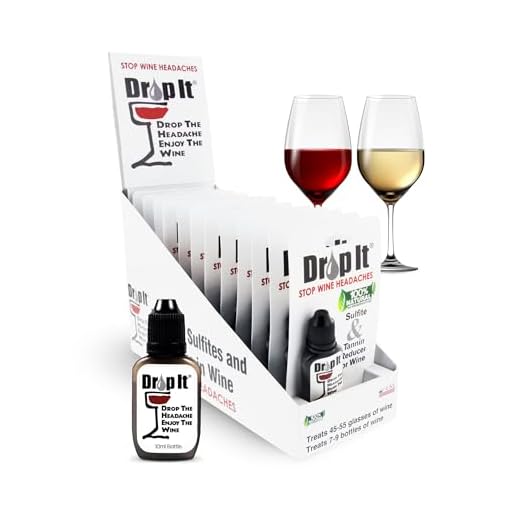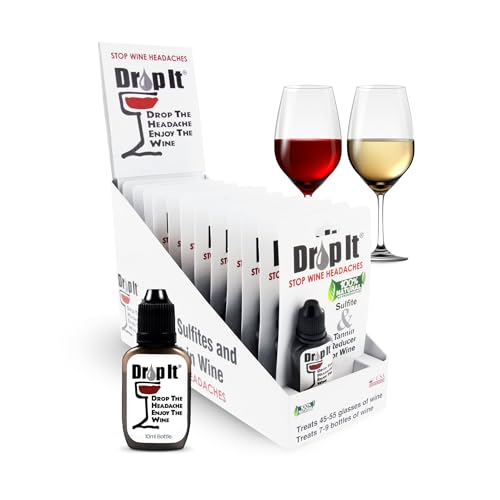



Yes, certain types of lighter-colored beverages can exhibit astringent qualities, although they are generally less pronounced compared to their darker counterparts. This characteristic can depend on various factors, including the grape variety, fermentation process, and aging methods.
For instance, some varietals like Sauvignon Blanc and Chardonnay may present subtle notes of astringency, particularly if they undergo extended skin contact during vinification. Understanding these nuances is crucial for anyone looking to enhance their tasting experience or food pairings.
When selecting a bottle, consider those produced in regions known for their unique terroirs, which can influence the presence of astringent compounds. Exploring options like an oaked Chardonnay can offer a richer palate, while a crisp, unoaked version might be more refreshing and vibrant.
Ultimately, the exploration of these beverages reveals the intricate balance of flavor profiles and textures, making each tasting an opportunity for discovery and enjoyment.
Do White Varietals Contain Tannins?
Yes, certain varietals can exhibit astringency, albeit typically at lower levels than their darker counterparts. The presence of these compounds often hinges on the winemaking process, particularly the use of skins during fermentation. For instance, some producers intentionally allow skin contact for a brief period, resulting in a more textured mouthfeel and subtle grip on the palate.
It’s essential to recognize that not all light-bodied options are devoid of these compounds. Some regions and styles, such as skin-fermented versions or those crafted from specific grapes like Pinot Grigio, can showcase notable astringency. Therefore, when selecting a bottle, consider the producer’s technique and the grape variety, as these factors significantly influence the final profile.
Pairing these selections with food can enhance their complexity. For a delightful experience, consider enjoying them with dishes that include roasted vegetables or grilled proteins. If you’re looking for a tasty side to complement your meal, how to cook a baked potato in the airfryer can be an excellent choice to elevate your dining experience.
Ultimately, exploration is key. Don’t hesitate to try different styles and regions to discover how these compounds can vary. Each bottle tells a story, and understanding the nuances can deepen your appreciation for what’s in your glass.
Understanding Tannins in Wine Chemistry
The presence of these polyphenolic compounds can vary significantly across different types of grape varieties and winemaking techniques. While some varieties, particularly those that undergo extended skin contact, may exhibit a higher concentration, others remain lower in these components. It is essential to recognize that the extraction process during fermentation plays a crucial role in determining the final profile.
Key Sources of Tannins
Primary sources include grape skins, seeds, and stems. Each source contributes distinct characteristics. For instance, skins impart a more rounded mouthfeel, while seeds can introduce astringency. The role of oak barrels cannot be overlooked, as they can add additional layers of complexity and structure due to the tannins present in the wood.
Impact on Flavor and Structure
The interaction with other elements, such as acidity and sweetness, profoundly shapes the overall balance of the beverage. This balance influences not only the taste but also the aging potential. As the drink matures, these compounds can soften, leading to a more harmonious experience. Understanding the dynamics of these components is key to appreciating the nuances of any beverage, enhancing both appreciation and selection for various culinary pairings.
Key Differences Between Red and White Wine Tannins
Understanding the distinct characteristics of astringent compounds in red and lighter varieties is essential for any wine enthusiast. Here are the primary variances:
Source of Tannins
- Red varieties derive their astringency primarily from grape skins and seeds during fermentation.
- Lighter varieties often lack prolonged skin contact, resulting in lower levels of these phenolic compounds.
Texture and Mouthfeel
- Red varieties typically present a robust and velvety texture, contributing to a fuller mouthfeel.
- Lighter counterparts tend to offer a more delicate and crisp sensation on the palate.
The balance of acidity and sweetness plays a significant role in how these astringent elements are perceived. In red varieties, the higher acidity often complements the stronger astringency, while in lighter types, the focus shifts towards refreshing qualities with subtle hints of structure.
Exploring these differences can enhance your appreciation of each style and improve your pairing skills when matching with various dishes. Understanding the nuances allows for more informed choices when selecting a glass to complement your meal.
Common White Wine Varieties and Their Tannin Levels
Understanding the astringency profiles of popular varieties can greatly enhance your appreciation and selection process. Here’s a brief overview of some notable types.
Sauvignon Blanc
This variety typically showcases minimal astringency due to its low concentration of polyphenols. Fresh and zesty, it’s often enjoyed for its crisp acidity rather than any bitter notes.
Chardonnay
With its diverse styles, the astringent character varies significantly. Oaked versions may exhibit some tannic structure, especially if aged in barrels, while unoaked iterations tend to be smoother and lighter on the palate.
Riesling
Generally, this grape presents a low level of astringency, focusing on floral and fruity characteristics. Known for its high acidity, it balances sweetness without any noticeable dryness.
Pinot Grigio
This variety is characterized by its light body and crispness, often having negligible astringent qualities. It’s typically refreshing, making it a popular choice for casual sipping.
Gewürztraminer
Known for its aromatic intensity, this type generally offers minimal astringency. The focus is on its exotic flavors and lush texture rather than any bitterness.
Choosing a variety depends on personal preference and the desired pairing. For those who enjoy a slight astringent bite, exploring oaked Chardonnays might be a rewarding experience. Otherwise, sticking to aromatic or crisp options like Riesling and Pinot Grigio can provide a delightful, smooth experience.
How Tannins Affect the Flavor Profile of White Wines
The presence of polyphenolic compounds plays a significant role in shaping the taste of lighter varietals. These compounds can impart astringency and complexity, subtly influencing the overall sensory experience.
Impact on Mouthfeel
Incorporating these compounds can elevate the texture, contributing a silky or creamy sensation. This is particularly noticeable in selections that undergo malolactic fermentation, like certain Chardonnay styles, where the interaction with these phenolics enhances the wine’s body and richness.
Flavor Development
These compounds can also affect aromatic profiles, creating depth and nuance. For instance, wines with higher levels of these substances might exhibit flavors of stone fruit, citrus zest, or floral notes, complemented by a slight bitterness that balances sweetness. This complexity can be crucial when pairing with food, as it enhances the overall dining experience.
| Wine Type | Tannin Level | Flavor Characteristics |
|---|---|---|
| Chardonnay | Medium | Creamy, buttery, stone fruit |
| Viognier | Low | Floral, peach, apricot |
| Sauvignon Blanc | Low to Medium | Citrus, grassy, herbaceous |
| Gewürztraminer | Very Low | Spicy, lychee, rose |
Understanding the interaction between these compounds and the other elements in the glass can significantly enhance your appreciation and selection process. Experimenting with different varietals and their unique profiles will lead to a richer experience, whether enjoyed alone or paired with a meal.
Identifying Tannins in White Wines: Tips for Beginners
To detect the presence of polyphenolic compounds in lighter varietals, focus on these practical approaches:
Visual Assessment
- Examine the clarity and color. A deeper hue might suggest a higher concentration of these compounds.
- Swirl the liquid in the glass. Observe how it clings to the sides; this viscosity can hint at the structure and presence of astringency.
Olfactory Exploration
- Take a moment to inhale the aromas. Fruity and floral notes may dominate, but subtle hints of herbal or earthy scents can indicate complexity.
- After swirling, allow the wine to breathe. This can enhance the aromatic profile, revealing more layers.
Tactile Experience
- Take a small sip and roll it over your palate. Notice any drying sensation; this is a key indicator of astringent qualities.
- Pay attention to the finish. A lingering, slightly bitter aftertaste can signify the presence of these compounds.
By employing these techniques, you’ll better appreciate the nuances in various selections and elevate your tasting skills. Experimenting with different varietals will further enhance your understanding of how these compounds interact within diverse profiles.
Food Pairing Suggestions Considering Tannin Content
For a delightful experience, consider pairing seafood dishes with a crisp Sauvignon Blanc. The natural acidity enhances the flavors of the fish, while the subtle astringency can complement the texture of shellfish.
Opt for a Chardonnay, especially if it’s oaked, alongside roasted chicken. The creamy mouthfeel and slight bitterness from the wood can harmonize beautifully with the savory notes of the bird.
Vegetarian Options
Pair a light, floral varietal like Pinot Grigio with vegetable risotto. The freshness of the wine cuts through the richness of the dish, balancing the flavors effectively.
Cheese Matches
When serving cheeses, a Chenin Blanc can work well with goat cheese, as the acidity and slight grip enhance the tanginess of the cheese. For creamier cheeses like Brie, try a lightly oaked varietal that complements the smooth texture without overwhelming it.
Exploring Low-Tannin Options
For those seeking lighter selections, I recommend exploring varieties such as Pinot Grigio and Sauvignon Blanc. Both tend to exhibit minimal astringency, allowing for a refreshing experience without the overwhelming grip that can accompany higher tannin profiles.
Pinot Grigio
This Italian classic showcases bright acidity and floral notes, making it an excellent choice for seafood dishes or light salads. Its low tannin level allows the fruit flavors to shine, creating a clean and crisp palate.
Sauvignon Blanc
Originating from regions like New Zealand and California, this variety offers vibrant citrus and herbal characteristics. Its natural acidity pairs beautifully with dishes featuring goat cheese or fresh vegetables, enhancing the overall dining experience.
Other noteworthy options include Grüner Veltliner and Riesling. Grüner Veltliner provides a peppery finish and pairs well with Asian cuisine, while Riesling, especially in its dry form, complements spicy dishes without overwhelming the senses.
When selecting your next bottle, consider exploring these low-astringency options. They can elevate your meals while providing a delightful tasting experience without the heavier tannin impact found in many reds.










